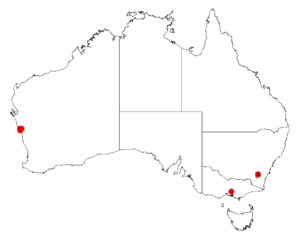Guinet's wattle facts for kids
Acacia guinetii, also known as Guinet's wattle, is a special type of shrub. It belongs to the large Acacia family, which includes many different wattles. This plant is found only in a small part of the coast in western Australia. This means it is endemic to that area, growing naturally nowhere else in the world!
Quick facts for kids Guinet's wattle |
|
|---|---|
| Conservation status | |
| Scientific classification | |
| Genus: |
Acacia
|
| Species: |
guinetii
|
 |
|
| Occurrence data from AVH | |
Contents
What Guinet's Wattle Looks Like
This amazing evergreen shrub can grow from about 0.3 to 2 metres (1.0 to 6.6 ft) tall. It can also spread out to about 2.5 m (8 ft 2 in) wide. Its branches often arch downwards and are a bit hairy.
The leaves of Guinet's wattle are interesting. They have one pair of small leaf branches, each about 4 to 10 mm (0.16 to 0.39 in) long. On these branches, you'll find three to four pairs of tiny, green leaflets called pinnules. These leaflets are hairy and curve backwards. They are about 4 to 7 mm (0.16 to 0.28 in) long and 1 to 2 mm (0.039 to 0.079 in) wide.
This wattle blooms from June to September, showing off bright yellow flowers. Its flower clusters are round, like little balls, and are packed with 50 to 75 golden flowers. After the flowers, the plant grows seed pods. These pods are about 2 to 4 cm (0.79 to 1.57 in) long and 3 to 4 mm (0.12 to 0.16 in) wide. Inside, they hold oblong-shaped seeds, each about 3 mm (0.12 in) long.
How Scientists Named Guinet's Wattle
Scientists give plants special names so everyone knows exactly which plant they are talking about. This is called taxonomy. The first time Acacia guinetii was officially described was in 1979. A botanist named Bruce Maslin did this work. He published his findings in a science journal called Nuytsia.
Later, in 2003, another scientist named Leslie Pedley changed its name to Racosperma guinetii. But then, in 2006, it was changed back to its original name, Acacia guinetii. This plant is part of the Acacia pulchella group of wattles. It also looks a bit like Acacia lasiocarpa.
Where Guinet's Wattle Grows Naturally
Guinet's wattle grows naturally in a small area along the coast of Western Australia. You can find it in the Mid West region. It lives on rocky hills, often in gravelly or rocky soils. Its natural home stretches from around Northampton in the north down to Geraldton in the south. It usually grows as part of low-growing plant communities called heathlands.
Growing Guinet's Wattle in Your Garden
You can buy Guinet's wattle from plant nurseries! It's a great plant for gardens because it has thick leaves and a low, spreading shape. In winter and spring, it produces lots of fluffy, yellow, ball-shaped flowers, which look beautiful.
This wattle grows quite fast. It likes full sun and can handle a little bit of frost and dry weather (drought). However, it's important that the soil drains well, meaning water doesn't sit around its roots. You can plant it along a border, in a rock garden, or as part of a larger shrub area.


